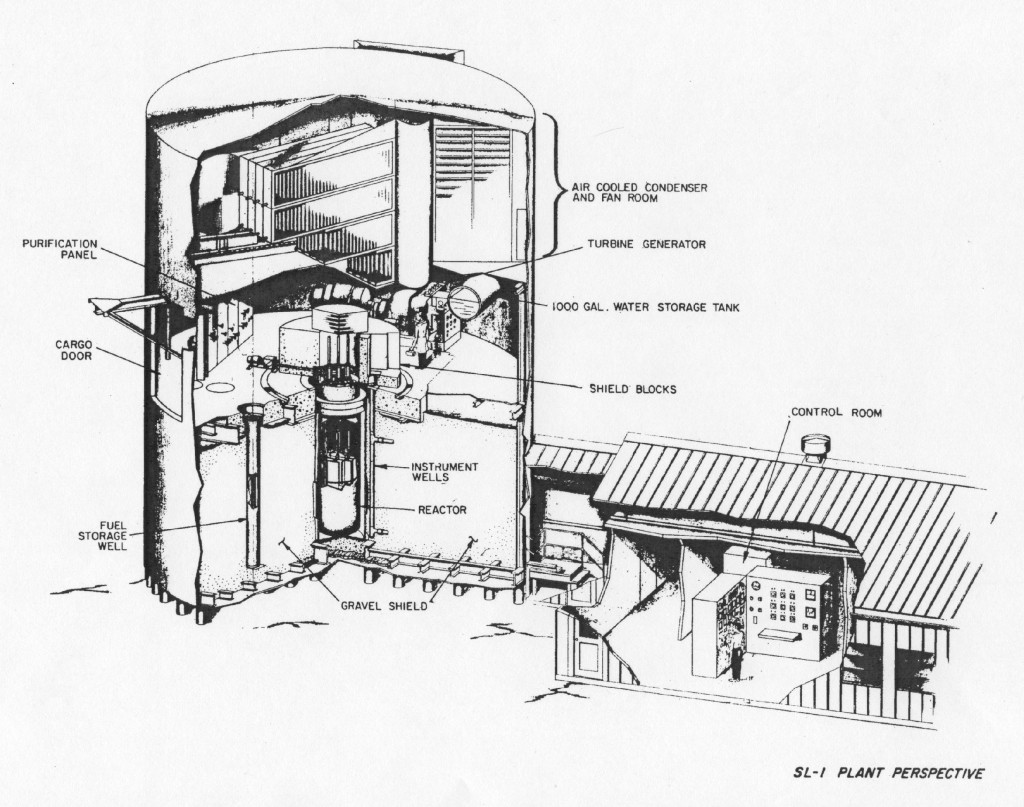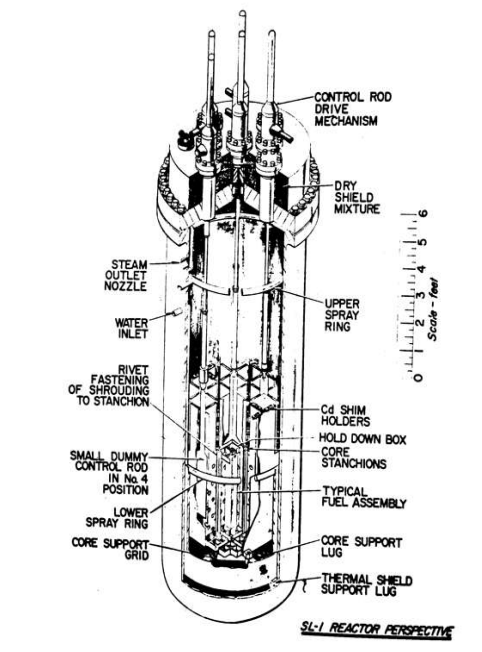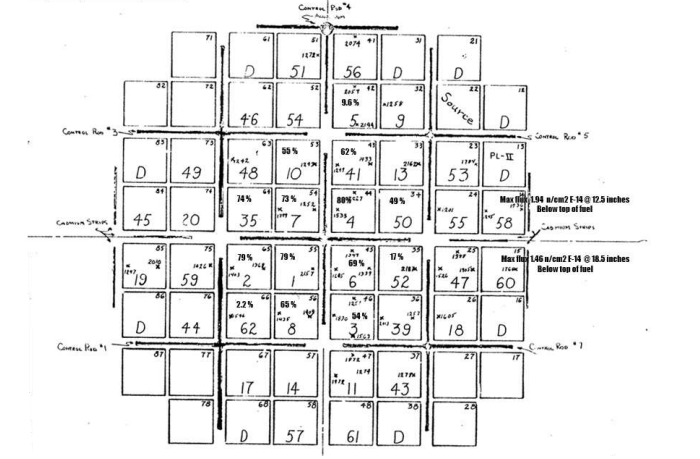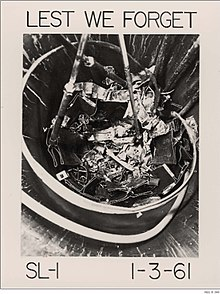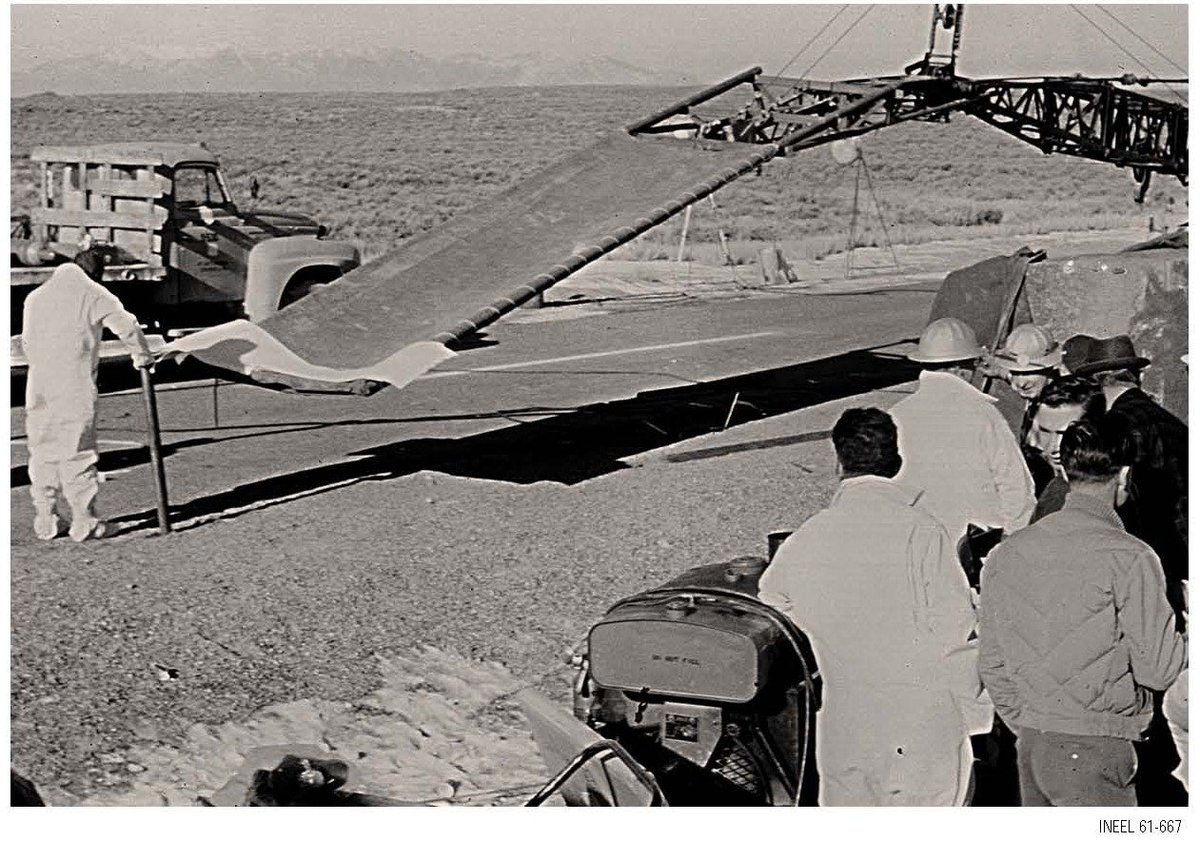Its time. Time to talk SL-1, which prior to TMI was one of the most catastrophic reactor failures in the United States that was not intentional.
Many posts to follow, but first lest orient ourselves around SL-1: What was it?
Many posts to follow, but first lest orient ourselves around SL-1: What was it?
SL-1& #39;s goal was to allow the Army to replace diesel generators at Arctic bases with small, portable nuclear reactors to provide power and heat/steam. It was a natural circulation reactor i.e. no pumps required to enhance portability.
Lessons learned from the BORAX series of test reactors were applied, and the 3MW (thermal) reactor was small enough to fit into a military cargo plane for transport. Operating on HEU at 93.2%, with 59 fuel assemblies, 9 active control rods and a single neutron source for ignition
The small fuel footprint made the center of the reactor highly energetic and the control rod in the center a focus point of neutron flux. That& #39;s where this starts to go wrong....
@nuclearkatie @Antiproton_com @NuclearAnthro @GigaBecquerel
@nuclearkatie @Antiproton_com @NuclearAnthro @GigaBecquerel
In testing it was quickly determined that of the 9 control rods, 5 were basically redundant acting mainly as neutron absorbsers and not used actively by the cadre operating the reactor. The cadmium control rods were in a + arrangement in the center of the reactor
The center rod was the lynchpin and was the one mainly used to control reactivity in testing after the other & #39;active& #39; rods were found to be unnecessary, the abnormally reactive center meant that a single rod could spike reactivity....which is what happened 3rd Jan 1961....
SL-1 was underoing maintenance by the 3 DOD cadre, who had disconnected the center control rod to calibrate instruments, add aluminium-cobalt flux wires, and being prep& #39;ed for restart after the Holidays. As part of the procedures the center rod needed to be re-attached
...after being disconnected to carry out the tasks. To reconnect it the control rod had to be removed 4 inches manually to reconnect.
It was removed 26 inches. Possibly the control rod because stuck and they had to use extra effort to remove it.
It was removed 26 inches. Possibly the control rod because stuck and they had to use extra effort to remove it.
Whatever the reason, it was 22 inches too far. The reactor went prompt critical and created a massive steam bubble that water hammered the lid of reactor, lifting the ENTIRE reactor 9ft and 1 inch above its normal height and ejecting the shield plugs as pressure exceeded 10k psi
The sudden jump in reactivity not only promptly flashed the water to steam in a bubble, but vaporized some of the fuel
It was all over within 10 second, of the three cadre, two were instantly killed, and one was pinned to the ceiling by a reactor shield plug, and was likely alive for at least an hour, but regardless would& #39;ve died from the radiation received.
All metal items on the cadre were radioactive afterwords. Originally no one knew due to a couple false fire alarms earlier in the day, and when the alarm went off again Fire officers approached assuming nothing was wrong until they entered the reactor building their meters spiked
The 3MW reactor had likely jumped to 20MW during its prompt criticality, the only thing stopping it being the destruction of its fuel assemblies and moderators.
3 times crews entered the reactor only to retreat due to radiation levels. The two personnel on the floor were retrieved, one still alive and moaning from the floor with a 1 minute limit on exposure. An hour later the third was discovered on the ceiling unrecognizable.
A special crane arm with a stretcher was used to remove the body pinned to the ceiling.
Prior to the radioactivity of the mens belongings, it was believes that the reactor was inherently safe, but the neutron bombarded belongings proved the reactor had gone critical.
Prior to the radioactivity of the mens belongings, it was believes that the reactor was inherently safe, but the neutron bombarded belongings proved the reactor had gone critical.
The reactor was torn down post incident analysis and buried
at Idaho National Laboratory off Filmore Blvd: https://goo.gl/maps/UbTpkisorbo2ik8g7">https://goo.gl/maps/UbTp...
at Idaho National Laboratory off Filmore Blvd: https://goo.gl/maps/UbTpkisorbo2ik8g7">https://goo.gl/maps/UbTp...
The SL-1 was cancelled due to its instability, the Army instead focusing on the ML-1 reactor which would continue until 1965.
One misconception was that the LS-1 sparked the & #39;Single Rod Criterion& #39;. It did not, that was already well known thanks to the US Navy reactors.
One misconception was that the LS-1 sparked the & #39;Single Rod Criterion& #39;. It did not, that was already well known thanks to the US Navy reactors.
However the SL-1 incident helped ensure the Single Rod Criterion was adopted by Commercial Reactors, and the SL-1 became the only lethal reactor accident in the US to this day.

 Read on Twitter
Read on Twitter